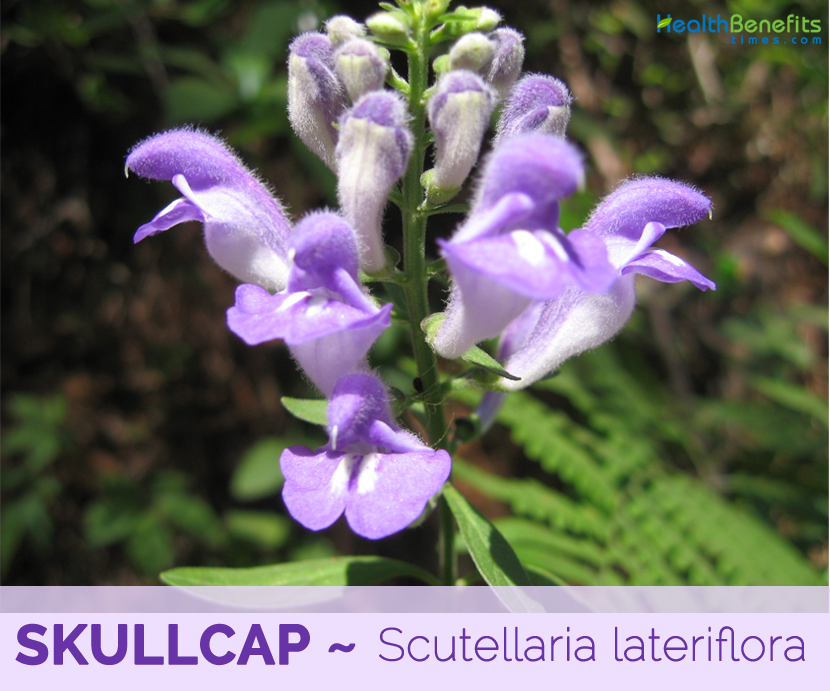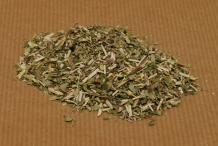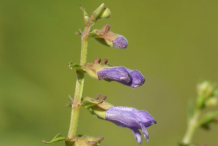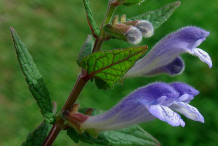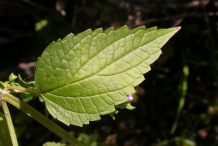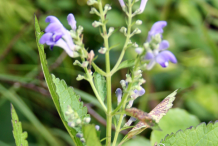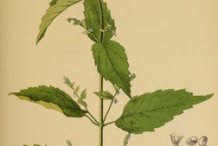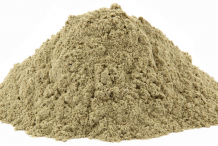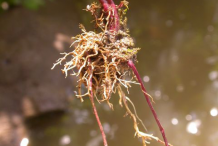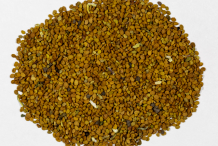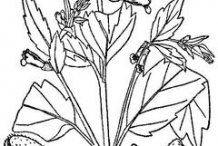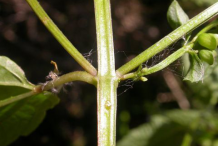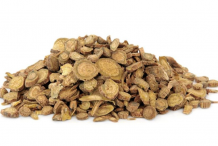Plant Description
Skullcap is an herbaceous, slender, rarely shrubby, labiate plant that grows about 1 m in height. The plant grows in moist sedge meadows, openings in floodplain woodlands, soggy thickets, swamps, bogs, seeps and springs, edges of vernal pools and ponds, moist depressions in limestone glades, and shaded areas of cliffs. The plant grows well in sandy, rocky and dry soils, and in cultivated planting beds. It also prefers wet to moist soil with plenty of organic matter. The roots system consists of a taproot and rhizomes. Stem is light green to pale reddish-green, 4-angled, and hairless or sparsely canescent; they have a tendency to sprawl.
Leaves
Blades of the opposite leaves are up to 7.5 centimeters long by 5 centimeters wide, they are cordate-ovate to broadly lanceolate, hairless, and coarsely serrated along the margins. On the upper surface of each leaf blade, there is a conspicuous network of veins. The petioles of the leaves are light green to pale reddish green, slender, and up to 1 inch long.
Flower & Fruit
Blue lavender flowers are hooded, tube-shaped and two-lipped, with the upper lip forming a hood and the lower lip having two lobes. Flowering normally takes place from Jun to August. The flowers are replaced by a two-chamber seed pod containing four seeds. Most of the flowers do not appear at the top of the main stem, but are produced along the length of side branches that grow from the leaf axils. The aerial (above-ground) parts of the plant are collected during the flowering period and are used in herbal preparations in western herbal medicine. The root of an Asian species (S. baicalensis) is frequently used in Traditional Chinese Medicine. It has been used for more than 200 years as a mild relaxant and as a therapy for anxiety, nervous tension, and convulsions.
Types
Skullcap can refer to 2 herbs: American skullcap (Scutellaria lateriflora) and Chinese skullcap (Scutellaria baicalensis). Both forms of skullcap are used to treat different conditions and are not interchangeable.
1. American Skullcap
American skullcap has long been used in North America for anxiety and the promotion of relaxation. Skullcap is ideal to take before a nightcap so that you are wearing as many ‘caps’ as possible… One study found that blue skullcap and common skullcap when used in herbal tea could have an anxiety reducing effect across 19 volunteers.
2. Chinese Skullcap
Chinese skullcap has been used to help treat a large number of conditions and has been shown to be a useful anti-inflammatory. Thus it might be a soothing drink for those with conditions such as arthritis and bowel diseases which cause uncomfortable inflammation.
It has also been implicated in the treatment of cancer where it has been used in China historically. A recent study demonstrated that the tea may help to induce apoptosis in certain cancerous cells (cell death) which could potentially be beneficial in treating various cases. However it’s important to note that in different cancers the cells react differently and it is never advisable to attempt to self-medicate for cancer. Over 295 compounds have been isolated from scutellaria, which include flavonoids and antioxidants. However, with over 350 different species of skullcap it would be hard to know if you were using a genuine product. Speak to your doctor, and if you are interested ask them about the tea.
Health Benefits of Skullcap
Skullcap is a minty perennial herb which has tiny purple flowers and offers many health benefits. The Skullcap herb has shown powerful antioxidant effects, helps calm nerves, treats fever, and has a synergistic effect that helps other herbs and supplements be better absorbed. Let’s take a closer look at some of the impressive health benefits of this amazing herb.
1. Soothes Nervous System
If you suffer from a nervous disorder, you may have experienced seizures or other spasmodic side effects that result from a problem in your nervous system. Skullcap tea helps to soothe the nervous system and prevent these episodes. It has been traditionally used to reduce seizure frequency and severity in those patients. Adding skullcap to drinking water once a day has also been related with this positive benefit.(1)
2. Manages Diabetes
Insulin and glucose regulation is essential and it appears that skullcap is able to increase the production of insulin by the pancreas and helps to control the insulin levels in the body. Additionally, it has been linked to lower cholesterol levels, which is an aggravating factor in diabetes.(2)
3. Reduces Inflammation
Skullcap has some pretty effective anti-inflammatory properties. Many who suffer with arthritis and inflammatory bowel diseases are using skullcap as a home remedy. Research has shown benefits to those who have Alzheimer’s disease and Parkinson’s disease due to its anti-inflammatory effects.(3)
4. Prevents Cancer
Skullcap is an herbal remedy that has been known to encourage apoptosis (sudden cell death), in cancerous cells and is used for natural treatment of cancer. This action is supposed to be caused by the antioxidant flavone components of the herb. This herb avoids the spread of cancerous cells and slows tumor growth, thus giving other cancer treatments a chance to take effect and win the ultimate battle against the disease.(4)
5. Relieves Anxiety
Skullcap tea is a wonderful method to balance the hormones in your body, as it encourages the release of endorphins and generally balances your mood. If you are feeling worked up for no reason, and continually feel tense, then perhaps what you need is a simple cup of tea. Phenolic compounds can have a wide range of effect on our hormonal balance, as they happen to be rich in antioxidant compounds. There are many herbs such as saw palmetto that can provide relief from stress and anxiety.(5)
6. Heart Health
Skullcap helps to reduce the level of cholesterol in the heart. It helps to lower the chances of atherosclerosis, heart attacks, coronary heart diseases, and strokes that frequently accompany the build-up of plaque in the arteries.(6)
7. Can Help You Get Some Shut-Eye
Although skullcap may help with anxiety, it can also help those who experience insomnia and other sleeping problems, such as restlessness, muscle tension and clenching the jaws. Skullcap tea or tincture could be useful before bed to help you relax, ward off any anxiety and give you some well-deserved and much-needed sleep.(7)
8. Removes Toxins
If you are looking for a way to detoxify your body and boost your overall health, skullcap tea may be just the thing. Skullcap has been related with an increased antioxidant activity in the liver, which is one of the slowest-recovering organs, and this effect can considerably boost the efficiency of your liver. This helps to reduce toxin levels in the body and blood, thus improving overall health and wellness. (8)
9. Weight Loss
Although the research on this particular aspect of skullcap is still unclear, it appears that the reduction of triglycerides motivated by this herb can help with rapid weight loss when combined with a proper diet. This research is ongoing but presents an option for those looking for new ways to lose weight.
10. May Treat Epilepsy and Reduce Muscle Spasms
Research shows that Ayurveda techniques and treatments using herbal medicine, such as skullcap, may be helpful in treating epilepsy. Specifically, skullcap is an Ayurvedic herbal preparation that’s been described as being used for epilepsy treatment. In addition, Ayurvedic ingredients were combined using a base of honey and herbal ghee. This cocktail of herbal ingredients clearly help to reduce tremors, muscle spasms, nerve-related symptoms and headaches, ultimately aiding in the treatment of side effects caused from epileptic patients.
An animal research in Laurentian University in Canada showed that skullcap help to reduce the risk and occurrence of seizures. Male rats were given skullcap for a period of time after being diagnosed with epilepsy and did not have seizures, while those not given the herb did. Interestingly, when the treatment was removed, seizures did occur.(9), (10)
11. Reduces Pain
Skullcap possesses certain analgesic properties, meaning that consuming it can help to relieve pain throughout the body, partially through a reduction in inflammation. However, you can form a paste of the dried one and apply it directly to the areas that are experiencing pain. This can be a major boost for the healing of wounds or if you are recovering from an injury. Also, small scrapes and bruises can be healed more rapidly by applying it topically, as the rich phenolic compounds and flavones stimulate blood flow to the skin and help prevent infection.(11)
12. Prevent Parkinson’s disease
Health benefits of skullcap also include the ability to protect nerve cells against damage related to Parkinson’s disease that is considered to be a chronic condition causing tremor, the stiffness of the trunk and limbs, slowing of movement, and impaired balance and coordination. It is because this herb contains an antioxidant called baicalein that is very helpful for limiting the occurrence of this specific disease.
Traditional uses and benefits of Skullcap
- Skullcap is used in herbal medicine as a mild sedative and sleep promoter.
- Skullcap is a very effective nervine that has traditionally been used in the treatment of a wide range of nervous conditions.
- Its tonic and restorative properties help to support and nourish the nervous system, calming and relieving stress and anxiety.
- Leaves are antispasmodic, slightly astringent, diuretic, nervine, sedative and strongly tonic.
- It is used in the treatment of various problems of the nervous system including epilepsy, insomnia, anxiety, delirium tremens, withdrawal from barbiturates and tranquillizers, and neuralgia.
- An infusion of the plant has been used to promote suppressed menstruation, relieve breast pain and encourage expulsion of the placenta.
- Plant was once believed of use in the treatment of rabies.
- Some Native American tribes used it as an emmenagogue to bring young girls into womanhood.
- It was traditionally used to bring on visions (in large doses) during spiritual ceremonies.
- It was once used as a treatment for rabies and schizophrenia.
- It is helpful in the treatment of many nervous conditions such as epilepsy, hysteria, anxiety, delirium tremens and as a remedy for panic attacks.
- It has also been found useful in treating symptoms of withdrawal from barbiturates and tranquilizers.
- Medicinal infusions of this herb have been used to promote menstruation.
- An infusion of skullcap may also be helpful in treating throat infections and, due to its antispasmodic and sedative effects.
- It is also used for treating headaches from stress, neuralgia, and from incessant coughing.
- This herb can also be used to induce sleep naturally without the negative effects of many prescription and over-the-counter sleep aids.
- Skullcap is gaining some recognition as an alternative treatment for attention deficit disorder (ADHD/ADD).
- Plant is sometimes used to treat the symptoms associated with anorexia nervosa, fibromyalgia and even mild Tourette’s syndrome.
- Skullcap is used as an herbal treatment for asthma and as a hiccup and hangover remedy.
Ayurvedic Health benefits of Skullcap
- Gastroparesis: Prepare a decoction of skullcap root. Take one cup three times a day after each meal.
- Bone Pains: Prepare a tea of the dried herb. Drink twice a day.
- Alcoholism and Addiction: Prepare skullcap tea and give it to the patient every hour or two to drink. Start from half cup and reduce the quantity as the symptoms subside.
- Epilepsy and Bed witting: Put one tbsp dried skullcap in a cup of water and steep for half an hour. Take thrice daily.
- Anxiety: Boil one tbsp dried skullcap in a cup of water for 20-25 minutes. Cool and drink at least thrice a day.
- ADHD: Prepare a decoction of skullcap root. Take half cup two times a day.
- Aerophobia: Boil 1 tbsp of dried skullcap in one cup of water for 25 minutes. Strain it and drink thrice daily.
- Agoraphobia: Boil 1 tbsp of dried skullcap in one cup of water for 25 minutes. Drink it thrice daily.
- Claustrophobia: Put 2 tsp of dried skullcap roots in one cup of water. Boil it for 10 minutes. Drink it twice daily.
- Convulsions: Prepare a decoction, made of skullcap roots and one cup of hot water. Consume it twice daily. OR Buy Scutellaria mother tincture from a homeopathic shop. Put 10 drops of it in one glass of water. Drink it twice a day after meals.
- Cough: Prepare a decoction of Skullcap flower and Anemarrhena rhizome. Take it twice a day.
- Anxiety: Prepare a tea from mugwort, Valerian, Chamomile, St Johns Wort and Skullcap. Add ¼ tsp of each herb. Add honey. Drink once a day.
- Shingles: Grind together Oat straw seeds, St John’s wort flower and Skullcap root. Take two tsp two times a day with water.
- Addictions: Take leaves of catnip, Chamomile, peppermint and skullcap. Make a tea with it. Drink twice a day.
- Herpes: Take 20 g of dandelion root, 25 g of skullcap root, 30 g of dried plant of Purslane, 15 g of Pinella roots, 20 g of dried indigo plant, 30 g of American Ginseng root, 20 g of Cinnamon twig, 30 g of Bupleurum root, 20 g of dried plant of Thlaspi Arvense and 40 g of Licorice root. Grind them to make a powder. Add water in the required amount of the powder to make a paste. Apply it over external herpes.
- Fatigue: Take one tsp of each lobelia and skullcap. Mix half tsp of lemongrass and infuse in a cup of hot water 15 minutes. Drink Luke warm. It relaxes your tense muscles.
- Insomnia: Boil Skullcap and chamomile in equal amount to make a tea. Drink one cup in the evening. You may add some honey to improve the taste.
- Insomnia: Infuse a small tsp of dried Hawthorn berry and skullcap in a cup of water for 10-15 minutes. Drink one cup at bed time. You may also substitute skullcap by valerian.
- Piles: Notoginseng, Skullcap, Sophora, Callicerpa Formosana, Amber, Sanguisorba officinalis, Corydalis in conjunction are beneficial for Hemorrhoids. You may buy the formula, containing the above mentioned herbs. Capsule form is readily available. Consume 1 capsules 3 times a day.
Dosage and Administration
Skullcap is available in powder or liquid extract form and as a dried herb. It is commonly sold in capsule form as well.
The recommended dosage for adults is 1 to 2 grams of the dried herb, 2 to 3 cups of tea, 2 to 4 mL of the liquid extract three times daily, or 2 to 5 mL of the tincture three times daily.
Children may use skullcap but in small doses. The best method of delivery is a mild tea. The child’s physician should be consulted before use.
To make a medicinal tea try adding one pint of boiling water to 1 oz. of the dried herb and steep for 10 minutes. This can be served in half cup servings every few hours.
For children add 1 cup boiling water to 1 tsp. of dried leaves and steep only 2 minutes to yield a milder tea.
Precautions
- Tincture overdose causes giddiness, stupor, confusion and seizures.
- Possible liver toxicity.
- May interfere with the immune response.
- It should not be given to pregnant women since it can induce a miscarriage.
- Overdoses of the tincture cause giddiness, stupor, confusion of mind, twitching of the limbs, intermission of the pulse and other symptoms indicative of epilepsy.
- Avoid use for an ADHD suffered child who is below 6 yrs.
References:
https://www.itis.gov/servlet/SingleRpt/SingleRpt?search_topic=TSN&search_value=32765#null
http://pfaf.org/user/Plant.aspx?LatinName=Scutellaria+lateriflora
https://www.drugs.com/npp/scullcap.html
https://www.botanical.com/botanical/mgmh/s/scullc34.html
https://plants.usda.gov/core/profile?symbol=scla2
http://www.theplantlist.org/tpl1.1/record/kew-189301
http://www.umm.edu/health/medical/altmed/herb/skullcap
Comments
| Skullcap Quick Facts | |
|---|---|
| Name: | Skullcap |
| Scientific Name: | Scutellaria lateriflora |
| Origin | North America |
| Shapes | Two-chamber seed pod containing four seeds |
| Taste | Bitter |
| Health benefits | Relieves Anxiety and Prevents Cancer |
| Name | Skullcap |
|---|---|
| Scientific Name | Scutellaria lateriflora |
| Native | North America |
| Common Names | Scullcap, hoodwort, quaker bonnet, helmet flower, European skullcap, greater skullcap, American skullcap, blue skullcap, blue pimpernel, hooded willow herb, side-flowering skullcap, mad dog weed and mad weed, Virginian Skullcap |
| Name in Other Languages | Afrikaans: Kalotje Albanian: Skullcap Armenian: Tasak (թասակ) Arabic: Qalnaswa (قلنسوة) Azerbaijani: Dəyirmi Basque: Skullcap Belarusian: тюбетейка Bengali: Skullcap Bosnian: Kapica Bulgarian: кепе Catalan: Solideu Cebuano: Skullcap Chichewa: Skullcap Chinese: Tóugàigǔ (頭蓋骨) Croatian: Kapica Czech: Lebka Danish: Kalot Dutch: Kalotje Estonian: Pigimüts English: Blue skullcap, mad dog skullcap, Mad-dog, Virginian Scullcap Esperanto: Skullcap Filipino: Skullcap French: Toque, calotte Finnish: Kalotti Galician: Solidéu German: Skullcap Georgian: Skullcap Gujarati: Skullcap Greek: Skullcap(Skullcap) Haitian Creole: Kalot Hausa: Skullcap Hebrew: כיפה Hindi: Skalkaip (स्कल्कैप) Hmong: Skullcap Hungarian: Skullcap Icelandic: Skullcap Igbo: Skullcap Irish: Skullcap Italian: Zucchetto Indonesian: Skullcap Javanese: Skullcap Japanese: Zugaikotsu (頭蓋骨) Kannada: Buruḍe (ಬುರುಡೆ) Kazakh: Taqïya (тақия) Khmer: Skullcap Korean: Haegol moja (해골 모자) Latvian: Kipa Lithuanian: Slikė Lao: Skullcap Latin: Pileolum Malayalam: Teāppi (തൊപ്പി) Malagasy: Skullcap Malay: Berketayap Maori: Skullcap Marathi: Skullcap Mongolian: Skullcap Myanmar (Burmese): Skullcap Macedonian: Kapče (капче) Maltese: Skullcap Nepali: Skullcap Norwegian: Skullcap Persian: عرقچین Polish: Jarmułka Portuguese: Calota Romanian: Scufie Russian: Tyubeteyka (тюбетейка) Serbian: Kapica (капица) Sesotho: Skullcap Somali: Skullcap Swahili: Skullcap Sinhala: Skullcap Tajik: Skullcap Tamil: Skullcap Telugu: Skullcap Thai: H̄mwk klm mị̀mī pīk (หมวกกลมไม่มีปีก) Turkish: Takke Slovak: Lebky Slovenian: Čepica Spanish: Casquete Swedish: Kalott Ukrainian: Tyubeteyka (тюбетейка) Urdu: Skullcap Uzbek: Do’ppi Vietnamese: Hộp sọ Welsh: Cap corun Yiddish: Yarmlke (יאַרמלקע) Yoruba: Ate Zulu: Skullcap |
| Plant Growth Habit | Herbaceous, slender, rarely shrubby, labiate plants |
| Growing Climate | Moist sedge meadows, openings in floodplain woodlands, soggy thickets, swamps, bogs, seeps and springs, edges of vernal pools and ponds, moist depressions in limestone glades, and shaded areas of cliffs |
| Soil | Grow well in sandy, rocky and dry soils, and in cultivated planting beds. Prefers wet to moist soil with plenty of organic matter |
| Plant Size | About 1 m in height |
| Root | Taproot and rhizomes |
| Stem | Light green to pale reddish-green, 4-angled, and hairless or sparsely canescent; they have a tendency to sprawl |
| Leaf | Blades of the opposite leaves are up to 7.5 centimeters long by 5 centimeters wide, they are cordate-ovate to broadly lanceolate, hairless |
| Flowering Periods | Jun to August |
| Flower | Blue lavender flowers are hooded, tube-shaped and two-lipped, with the upper lip forming a hood and the lower lip having two lobes. |
| Fruit Shape & Size | Two-chamber seed pod containing four seeds |
| Taste | Bitter |
| Plant Parts Used | Whole herb, collected in June, dried and powdered |
| Available Forms | Tea, liquid extract, tincture, capsule or crude root extract |
| Season | Jul to September |
| Varieties |
|


